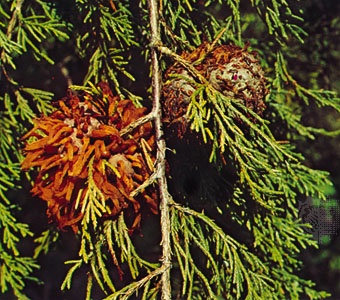cedar-apple rust
plant disease
 common disease in North America of red cedar (Juniperus virginiana (eastern red cedar)), related Juniperus (juniper) species, apple, and crab apple, caused by the fungus Gymnosporangium juniperi-virginianae. Both hosts, the junipers and the apples, are required for completion of the rust life cycle. Greenish-brown to chocolate-brown galls (cedar apples) that are round to kidney-shaped and up to two inches (5 centimetres) in diameter form on red cedar and other juniper twigs. In rainy spring weather, the galls are covered with jellylike, yellow to orange-brown spore horns up to two inches long. A single gall may produce several billion spores (basidiospores or sporidia). The wind-borne spores infect young leaves and fruits of apple and crab apple. Pale yellow to orange-yellow spots that develop sticky centres and minute, black fruiting bodies (pycnia) form on the leaves and usually near the calyx end of fruit. Orange, tubelike structures (aecia) later develop on the undersides of leaves and on fruits, which drop early. Spores produced in the aecia (aeciospores) are wind-borne in late summer to junipers on which leaf infections occur. Galls do not produce spores until the second spring, completing the two-year life cycle.
common disease in North America of red cedar (Juniperus virginiana (eastern red cedar)), related Juniperus (juniper) species, apple, and crab apple, caused by the fungus Gymnosporangium juniperi-virginianae. Both hosts, the junipers and the apples, are required for completion of the rust life cycle. Greenish-brown to chocolate-brown galls (cedar apples) that are round to kidney-shaped and up to two inches (5 centimetres) in diameter form on red cedar and other juniper twigs. In rainy spring weather, the galls are covered with jellylike, yellow to orange-brown spore horns up to two inches long. A single gall may produce several billion spores (basidiospores or sporidia). The wind-borne spores infect young leaves and fruits of apple and crab apple. Pale yellow to orange-yellow spots that develop sticky centres and minute, black fruiting bodies (pycnia) form on the leaves and usually near the calyx end of fruit. Orange, tubelike structures (aecia) later develop on the undersides of leaves and on fruits, which drop early. Spores produced in the aecia (aeciospores) are wind-borne in late summer to junipers on which leaf infections occur. Galls do not produce spores until the second spring, completing the two-year life cycle.Control is by eradication of either host or by timely application of a fungicide, in spring for junipers and in summer for apples.
- Lartet, Édouard Armand Isidore Hippolyte
- Lartigue, Jacques-Henri
- La Rue, Pierre de
- larva
- larvacean
- laryngeal cancer
- laryngeal hemiplegia
- laryngitis
- laryngology
- larynx
- La Révellière-Lépeaux, Louis-Marie de
- La Sale, Antoine de
- La Salle
- La Salle, René-Robert Cavelier, sieur (lord) de
- La Salle, Saint Jean-Baptiste de
- La Salle University
- LaSal Mountains
- Las Alpujarras
- Las Bela
- La Scala
- Lascaris, Constantine
- Lascaris, John
- Las Casas, Bartolomé de
- Las Cases, Emmanuel, Count (comte) de
- Lascaux Grotto